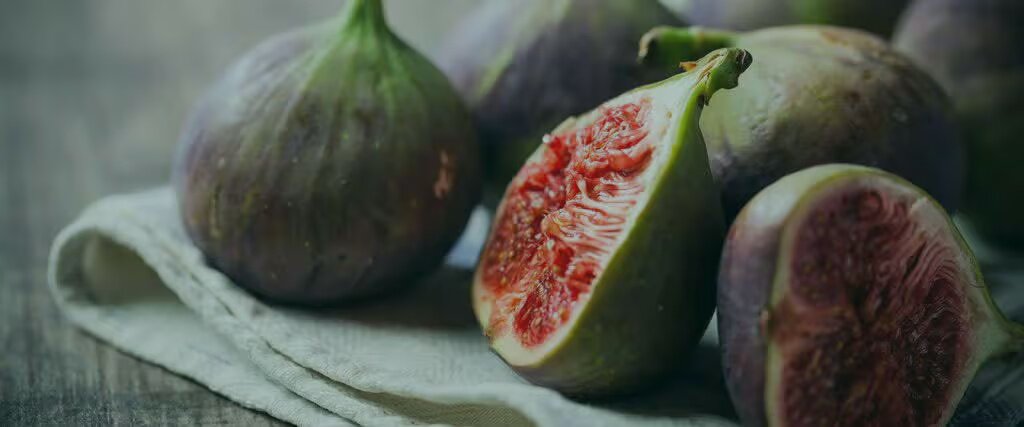Figs & Calcium – How Much Calcium In a Serving of Figs?

Did you know that more than 1,200 species of animals eat figs?
It’s true! Figs are so important to the world’s wildlife that ecologists have called the ficus tree– the tree that figs grow on– “a keystone resource.” Without them, whole ecosystems could collapse.
And it’s not hard to see why… figs are a deliciously sweet provider of a whole host of essential nutrients. In fact, figs are one of the most calcium-rich foods on the planet! Take a look at our “Top Calcium-Rich Foods” page and you’ll see dried figs are one of the best plant-based sources of calcium— even above kale and just below tofu!
But figs offer more than just calcium. So keep reading to discover how much calcium figs provide (as well as other nutrients), the amazing health benefits of figs and some recipe ideas that all 1,200 fig-eating species would enjoy!
How Much Calcium is in Figs?
Sure there’s a lot of calcium in figs. In fact, you get 162 mg of calcium in every 100 grams of dried figs. But there’s more to figs than just calcium.
Figs are also packed with fiber. As you may know, fiber keeps you “regular” by aiding digestion. It acts as the “greased chute” that keeps food moving through your digestive tract. Plus, fiber can also help you absorb more nutrients from your food too.
Not only that, but fiber can help increase your natural feeling of fullness so you eat healthy amounts at each meal.
Did you also know that figs are rich in antioxidants? So much so in fact, that dried figs show higher quality antioxidants levels than old-faithfuls like vitamin C and E. And among dried fruits, figs and prunes have the highest nutrient score.
After eating figs, you can enjoy an increase in antioxidant capacity for four hours!
Impress your friends factoid:
Fig trees don’t blossom in the traditional way. The blossom is actually inside the fruit! See, hundreds of tiny flowers grow on the inside and produce the crunchy, edible seeds that give figs their texture. Now you know!

Nutrients | Amount per 100 g |
|---|---|
Nutrients Calories | Amount per 100 g 249g |
Nutrients Protien | Amount per 100 g 3 g |
Nutrients Total Carbohydrate | Amount per 100 g 64 g |
Nutrients Dietary Fiber | Amount per 100 g 10 g |
Nutrients Sugars | Amount per 100 g 48 g |
Nutrients Total Fat | Amount per 100 g < 1 g |
Nutrients Calcium | Amount per 100 g 162 mg |
Nutrients Potassium | Amount per 100 g 680 mg |
Nutrients Magnesium | Amount per 100 g 68 mg |
Nutrients Phosphorus | Amount per 100 g 67 mg |
Fig Recipes

Figs are satisfying all on their own. But they’re also delightful with other ingredients.
In fact, many people will cut fresh figs and place them alongside different meats and cheeses on a scrumptious snack platter.
Or, for an exotic side dish, some folks make stuffed figs with goat cheese and walnuts …. or figs with parmesan and balsamic vinegar!
Figs also fit well in many salads. Try this salad below and see what you think:
Arugula Fig Almond Salad
This salad satisfies the sweet and savory lover.* Plus, it’s loaded with calcium! The following recipe serves 4, and is a perfect way to switch things up in the salad department any time of the year:
Place the balsamic vinegar in a small bowl, whisk in the olive oil. Season with salt and pepper to taste.
Layer 1/4 of the arugula and figs onto a small plate. Top with 1/4 of the almonds and feta. Drizzle with the balsamic vinaigrette. Repeat with the remaining ingredients on 3 other plates and enjoy!
Interactions / Precautions
Allergies and interactions to figs are uncommon. However, some people allergic to bee pollen may also be allergic to figs.
And since figs are in the mulberry family- if you’re allergic to mulberry- you’re wise to keep your distance!
Aside from allergies, figs have a clean profile. One thing to keep in mind though is fig’s high fiber content. Too many figs at a time can have a laxative effect. Of course, that also means it could be the natural remedy that constipated folks need too!
Beyond Figs: More Calcium-Rich Foods
It’s no wonder figs have been used for thousands of years as treats and natural remedies. The satisfying sweetness and clear health benefits are a powerful combination!
Plus, their ample calcium makes them perfect for anyone concerned with their bone health. So go enjoy some figs on their own, or try the little side dishes or salad recipe above!
If you’d like to see more calcium-rich foods, click here to find some of the best on the planet.
Or if you want to discover more about one particular food, here are some of the most popular calcium-rich foods explained: